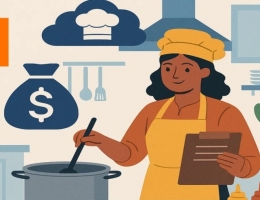
MSMEs can unlock ₹15,000 Crore Opportunity in India's Ice Cream Revolution
India's Ice Cream MSME Ecosystem: Growth, Opportunities, and Market Dynamics Post-GST Rationalization
Why MSMEs can Dominate the Ice Cream Market Now?
The ice cream industry presents an unprecedented ₹15,000-crore opportunity specifically tailored for MSME success following the GST reduction from 18% to 5%. With half of the ₹30,000-crore market still unorganized and one million outlets yet to be reached by corporate giants, MSMEs have a clear pathway to capture significant market share through their inherent advantages of local knowledge and agility. Unlike saturated FMCG segments where large players dominate, the ice cream sector offers MSMEs multiple entry points ranging from manufacturing and distribution to innovative retail formats. The GST rationalization has fundamentally leveled the playing field, allowing MSMEs to compete effectively with established players while serving underserved markets in tier 2 and tier 3 cities where large corporations have limited penetration.
Start Your Ice Cream Business with Just ₹5 Lakhs
PMFME offers 35% subsidy up to ₹10 lakhs, MUDRA provides collateral-free loans up to ₹10 lakhs, and CLCSS gives 15?pital subsidy for technology upgrades. Udyam Registration unlocks 3% interest subvention on working capital, while the Cold Chain scheme provides 35-50% grant for storage facilities. Stand-Up India facilitates ₹10 lakhs to ₹1 crore loans for women and SC/ST entrepreneurs.
MSMEs can enter with ₹5-10 lakhs for mobile units or ₹25-40 lakhs for manufacturing facilities. Contract manufacturing enables private label launches with minimal investment. MSMEs excel in local market understanding, creating region-specific flavors like sitaphal ice cream in Maharashtra or tender coconut in Kerala. Tier 2 and tier 3 operations enable direct farmer linkages, reducing milk costs by 15-20% while supporting local economies.
Complete Guide for MSMES to enter Ice Cream Industry
Entering the ice cream MSME industry requires strategic planning, regulatory compliance, and understanding of both opportunities and challenges. Prospective entrepreneurs must obtain MSME registration through the Udyam Registration portal (udyamregistration.gov.in), which provides benefits including priority sector lending and government scheme access. FSSAI (Food Safety and Standards Authority of India) licensing is mandatory for food manufacturing at fssai.gov.in, ensuring quality and safety standards. The SWOT analysis reveals significant strengths, growing market demand fueled by GST benefits and increasing disposable incomes; opportunities in tier 2 and tier 3 expansion as cooperatives set up plants closer to consumer markets; weaknesses, including high initial capital requirements for cold chain infrastructure and seasonal demand fluctuations; and threats from intense competition and dependency on dairy supply chains.
Building a Scalable MSME Ice Cream Business
MSMEs should begin with hyperlocal focus, targeting a 5-10 km radius with 100-150 retail points and 5-7 SKUs focusing on popular flavors with 40-50% gross margins. Implementation of cloud-based ERP systems costing ₹20,000-30,000 annually enables professional inventory management, while IoT sensors for cold chain monitoring reduce spoilage by 25%. Revenue projections indicate ₹50-75 lakhs in year one with 15-20?ITDA margins, growing to ₹1-1.5 crores in year two with 22-25% margins, and reaching ₹2-3 crores by year three with 28-30% margins.
After establishing initial market presence, MSMEs can scale through private label partnerships with supermarket chains ensuring assured off-take, while subscription models guarantee 30% recurring revenue. Value-added products like ice cream cakes and party packs with 60% higher margins help differentiate from commodity players. Creating MSME clusters for collective bargaining reduces raw material costs by 10-15%, while backward integration with dairy farmers ensures supply stability. MSMEs must maintain 45-60 days working capital with government schemes providing necessary financial support throughout the growth journey.
A Sweet Future for MSMEs in India's Ice Cream Revolution
The ice cream sector represents the most accessible high-growth opportunity for MSMEs in India's food processing landscape. Implementation of cloud-based ERP systems costing ₹20,000-30,000 annually and IoT sensors for cold chain monitoring can reduce spoilage by 25%. Well-managed MSMEs can achieve ₹50-75 lakhs revenue in year one with 15-20?ITDA margins, growing to ₹2-3 crores by year three with 28-30% margins—demonstrating exceptional growth potential. The convergence of GST benefits creating a 10-15% pricing advantage, untapped rural markets, and growing consumer demand for regional flavors positions MSMEs as transformation leaders capable of becoming regional champions within 3-5 years. As Peter Drucker stated, "The best way to predict the future is to create it." With government support through PMFME, MUDRA, and cold chain schemes, and by maintaining 45-60 days working capital, MSMEs have a clear path to sustainable growth.
In Ratan Tata's words, "Take the stones people throw at you and use them to build a monument." Indian MSMEs are now positioned to transform challenges into opportunities in the sweetest industry of all—unlocking frozen opportunities, celebrating regional flavors, and writing success stories that promise growth, profitability, and positive social impact.











